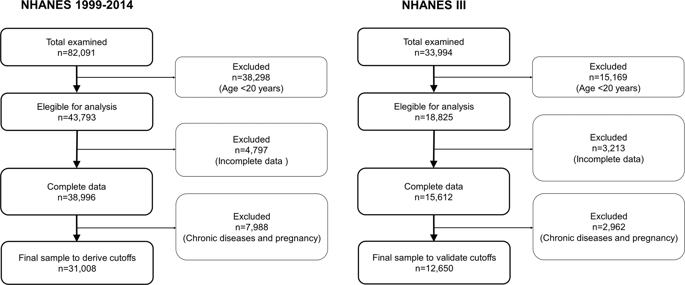International Journal of Obesity ( IF 4.9 ) Pub Date : 2020-01-07 , DOI: 10.1038/s41366-019-0516-8 Orison O Woolcott 1 , Richard N Bergman 1

|
Background/objectives
We have recently proposed and validated a simple and accurate method to estimate whole-body fat percentage in adults, the relative fat mass (RFM), derived from the ratio of height to waist circumference. We aimed to identify RFM cutoffs to diagnose obesity based on the association between RFM and all-cause mortality.
Subjects/methods
We used data from adult participants (≥20 years of age, n = 43,793) of the National Health and Nutrition Examination Survey (NHANES) 1999–2014 linked with death certificate records from the National Death Index. Optimal RFM cutoffs were determined using receiver-operating characteristic analysis (the Youden’s index and the Euclidean minimum distance to the coordinate (0,1)).
Results
Final dataset for analyses comprised 31,008 adults. During a median follow-up of 8.3 years (IQR, 7.6–13.7), 2,517 deaths occurred. Youden and Euclidean optimal cutoffs of baseline RFM for all-cause mortality were 40.8% and 41.6% for women, and 30.9% and 28.9% for men, respectively. Similar cutoffs were obtained using measured whole-body fat percentage by dual energy X-ray absorptiometry. Adjusting for age, BMI category, ethnicity, education level, and smoking status, the hazard ratio for mortality using Cox proportional hazard regression was 1.41 (95% CI, 1.02–1.95) among women who had an RFM of 40.0–44.9% compared with women who had an RFM <35% (P = 0.035). Among men, the hazard ratio was 1.57 (95% CI, 1.07–2.30) among those with an RFM of 30.0–34.9% compared with men who had an RFM <25% (P = 0.020). Similar adjusted hazard ratios for same RFM categories were obtained in our validation population (NHANES III, n = 12,650, median follow-up: 23.3 years): 1.42 (95% CI, 1.01–2.00) among women (P = 0.043) and 1.50 (95% CI, 1.07–2.10) among men (P = 0.021).
Conclusions
We suggest rounded RFM cutoffs of 40% for women and 30% for men to diagnose obesity and identify individuals at higher risk of death.
中文翻译:

使用相对脂肪量 (RFM) 定义诊断肥胖的临界值:与 NHANES 1999-2014 中的死亡率相关
背景/目标
我们最近提出并验证了一种简单而准确的方法来估计成人全身脂肪百分比,即相对脂肪量 (RFM),该方法源自身高与腰围的比率。我们旨在根据 RFM 与全因死亡率之间的关联确定 RFM 截止值以诊断肥胖。
科目/方法
我们使用了 1999-2014 年国家健康和营养检查调查 (NHANES) 的成年参与者(≥20 岁,n = 43,793)的数据,这些数据与国家死亡指数的死亡证明记录相关联。使用接收器操作特性分析(约登指数和欧几里德到坐标 (0,1) 的最小距离)确定最佳 RFM 截止值。
结果
分析的最终数据集包括 31,008 名成年人。在 8.3 年的中位随访期间(IQR,7.6-13.7),发生了 2,517 例死亡。对于全因死亡率,Youden 和欧几里得基线 RFM 的最佳截止值分别为女性 40.8% 和 41.6%,男性分别为 30.9% 和 28.9%。使用通过双能 X 射线吸收测定法测量的全身脂肪百分比获得了类似的截止值。调整年龄、BMI 类别、种族、教育水平和吸烟状况后,在 RFM 为 40.0-44.9% 的女性中,使用 Cox 比例风险回归的死亡率风险比为 1.41(95% CI,1.02-1.95),而RFM <35% 的女性 ( P = 0.035)。在男性中,RFM 为 30.0-34.9% 的男性与 RFM <25% 的男性相比,风险比为 1.57(95% CI,1.07-2.30)(P = 0.020)。在我们的验证人群(NHANES III, n = 12,650,中位随访时间:23.3 年)中获得了相同 RFM 类别的类似调整风险比:女性( P = 0.043)和 1.50 为1.42(95% CI,1.01-2.00) (95% CI, 1.07–2.10) 在男性中 ( P = 0.021)。
结论
我们建议女性和男性分别采用 40% 和 30% 的 RFM 截断值来诊断肥胖并识别死亡风险较高的个体。



























 京公网安备 11010802027423号
京公网安备 11010802027423号